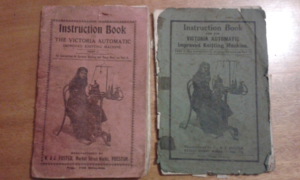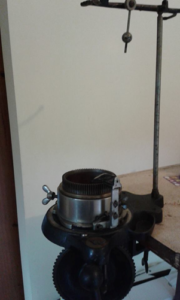The Victoria Automatic Improved Knitting Machine was developed and sold by W & J Foster, of Preston, between the years 1900-1925 . W & J Fosters is known to have manufactured knitting machines in Preston from the year’s 1862 right up to the 1960’s . Though precisely when the Victoria Knitting Machine was manufactured is not known. The early circular knitting machines became available around the 1860’s with them achieving some degree of popularity during the American Civil War.
The Victoria Automatic Improved Knitting Machine is a black metal, hand cranked circular knitting machine using latch needles to catch the yarn and pull it under the previous stitch . Thus a tube is knitted which can then be either hand stitched into socks, or with some careful manipulation a heel and toe can be constructed during manufacture of the tube.
In early days tubular knitting machines knitted plain tubes that were then cut off so that the toes and heels could be knitted by hand. It was so simple to knit these tubes using a sock knitting machine that English Workhouses had children as young as four producing tubes that could then be cut off and completed by older workers.
During World War 1 the allied countries had a huge demand for socks as these were needed by the men at the front. Thousands of women would get together in communities around Australia and other countries and knit socks . When knitting socks by hand, a hand knitter can produce a pair of socks in around one week. Socks could be produced on a sock knitting machine in around 40 minutes per pair . Families and individuals who owned sock machines put them to work producing socks for the war effort.

Figure 2. Victoria Knitting Machine- original instruction booklets. Bean, C. Authors Collection 2016
This Victoria Automatic Improved Knitting Machine was originally purchased by Alfred Smith sometime around the turn of the century. Exactly when the family came into possession of the sock machine is not known. It is known that it was Alfred Smith and not his wife Helen, who bought and used the sock machine .
According to Norma Warnecke the Victoria Sock knitting machine was bought new for the family prior to World War 1. Alfred used the knitting machine to make socks for himself and members of the family, he also used this machine to contribute to the War effort in World War 1. With the knitting machine there are still some scraps of barely legible paper that have notations on them attributed to Alfred Smith . More comprehensive notes were written by Alfred William Smith, son of Alfred Smith, who inherited the sock knitting machine. Alfred William Smiths notes include instructions for making socks for his wife Grace and their three children Norma, Jenny and Robert . Norma recalls her father using the knitting machine to knit socks for the family, she also recalls her father knitting socks for soldiers at the front during World War 2 .
Included in the tins of yarn and spare parts that were passed to Norma along with the knitting machine are remnants of socks that her father had knitted when the family were young. There are also a number of skeins of wool of a variety of different colours. One particular skein is of grey, it is the left over wool from Alfred Smiths contribution to the war effort in World War 1 . Additionally there are some skeins left over from Alfred William Smith, who also made socks, this time during World War 2 .
Both Alfred Smith and Alfred William Smith were in professions that were considered to be essential services during World War 1 and 2. Thus they were expected to contribute to the war effort in ways other than fighting at the front. Both Smith family members used the sock machine as one of the ways that they contributed to the health and comfort of those at the front .
Norma Warnecke used the sock machine when her own family was young, in the 1960’s and 1970’s. Among the hand written notes is a page in her handwriting that also gives details for socks for her children . On expressing my interest in a sock knitting machine in 2015, Norma Warnecke turned up the next day with the Victoria Knitting machine. It had been in her garage for decades and she had not thought that anyone would be interested in it. So when she found out that a family member was interested Norma decided that it was time to pass on the knitting machine to another family member. The Victoria knitting machine has now passed down four generations of the same family with each family member using it to create socks for themselves and other family members.
When I receive the sock knitting machine it came packaged with all the accessories including two original instruction manuals. Alfred William Smith had also stored wool from his father and from his own efforts in two Farex tins from when his daughter Jenny had been a baby along with details on the sizing needed for his family members. Today I am gradually learning more about how to use the machine so that I can make socks for my family members.
Figures
Figure 1. Victoria Knitting Machine. Bean, Christina (Authors Collection) 2016 1
Figure 2. Victoria Knitting Machine- original instruction booklets. Bean, C. Authors Collection 2016 2
Bibliography
Becker, P. (2004, August 17). Sock machine history. Retrieved August 5th, 2016, from The Marvelous Sock: https://sockmachine.wordpress.com/sock-machine-history/
Hawkins, M. (2015). A Short History of Machine Knitting. Retrieved August 5th, 2016, from The Guild of Machine Knitters: http://www.guild-mach-knit.org.uk/forms/history_part1.pdf
Instruction Book for the Victoria Automatic Improved Knitting Machine (Vol. 2). (n.a.). Market Street, Preston, United Kingdom: W & J Foster.
Instruction Book for the Victoria Automatic Improved Knitting Machine. (Vol. 1). (n.a). Market Street, Preston, United Kingdom: W & J Foster.
Lancashire Evening Post. (2011, June 2nd). Retrieved August 2016, 5th, from A century of proud history if back in the family: http://www.lep.co.uk/lifestyle/nostalgia/a-century-of-proud-history-is-back-in-the-family-1-3438253
One million pairs of socks: knitting for victory in the first world war. (2014, August 11). Retrieved August 5th, 2016, from The Conversation: http://theconversation.com/one-million-pairs-of-socks-knitting-for-victory-in-the-first-world-war-30149
Smith, A. (Unknown). Knitting notations.
Smith, A. W. (Unknown). Alfred William Smith Knitting Notations.
The Powerhouse Museum- Hand operated sock knitting machine, 1900-1925. (2016, August). Retrieved August 5th, 2016, from Powerhouse Museum: http://www.powerhousemuseum.com/collection/database/?irn=259421&search=sock+knitting+machine&images=&c=1&s=
Warnecke, N. (2016, July 18). Interview with Norma Warnecke- re Victoria Sock Knitting Machine. (C. Bean, Interviewer)
Warnecke, N. (Unknown). Knitting Notations.


Hello
I’m really interested in purchasing a circular sock machine and would love to find an Australian one. There are a few US and Canadian models available.
Hi Marion,
good luck with finding one. I found a few on ebay, but they were very expensive. When I was looking there did appear to be some New Zealand models that were available.
Good evening,. I am an avid spinner, hand and machine knitter who would love to master and own a cskm. Therefore would you possibly know anyone who has a cskm for sale as I would love to knit socks for my family and friends. I await in anticipation. Mrs J Bearryman.
I am sorry, I don’t know anyone that has one for sale. Now that I know about our knitting machine I use it.
I’ve created a free csm resource and on it is info on suppliers etc. Check it out http://www.csmlove.com
Hi all we have a sock machine for sale at our factory in huntingdale
Hi, would this sock machine still be available? I could be quite interested. Do you have details of what make and model and condition? Pho dogs would be great.
Regards
Leanne wills
Clunes
Victoria
Hi there do you have a price in mind and can you send a photo
I found a complete working Victoria auto sock making machine at a sale. Does anyone have an idea what they are worth?
When I went searching they were a couple of thousand dollars for a working one.
I have one for sale in perfect condition and the original box
You have a Victoria ?
Is it still available?
Have you ever used it?
Hi i have just been offered a sock machine in pieces, it has a name on it
Leichester 473 , does anyone have any info on this machine, i would so appreciate it.
I am sorry, I do not. Hopefully, your message here will reach someone that has more information than I do.
Are you sure that’s the name of the machine?
Story: https://www.google.ca/amp/s/www.newsweek.com/19th-century-machine-socks-built-last-502336%3famp=1
Griswold online manual
One version
https://www.angoravalley.com/sockmachines/manuals/griswold_sockmachine_manual.pdf
Another version
https://docs.google.com/file/d/0B0SPd9ju93MNNDE5M2ExZmEtOTExYy00MTEyLTlhNzUtNTE2NDQ2NjNmMGM0/edit?authkey=CLP9m7EK&pli=1&hl=en#
Hi I live in the Uk and would like to buy one of these preferably from the Uk as shipping and custom taxes would be to expensive, anyone selling one please get in touch.
https://sites.google.com/site/eventslistorg/system/app/pages/sitemap/hierarchy
Found last night cant figure out if available yet. Good luck.
This page is linked to my website at http://www.martin-green-shawls.co.uk
The email address is towards the bottom of the price list page.
Hello i have my great grans machine which has the name ” the helping hand” written on it. Made in england stamped elsehwwre and i think 14 on one part … im trying to find out what needles it needs as those are msising. It also has a bobbin winder a little detachamble shelf and the yarn thing weights buckeles and a lovely brass basket that moves up and down like aa brolly. Id love to find out when it was made and how old it is and how to figure out what needles it needs for the main cilinder and ribber. It has black pain with gold patterns and red inside cilinder and ribber. Thank you.
Hi Heloise,
I am not sure that I can help you.
To do some research into your knitting machine you will need to start researching the brand and when your machine may have been manufactured.
For needles, if you have an old needle there are plenty that are available online if you go searching for them. The ribbing needles are usually smaller than the main needles that are used in the drum of the machine.
The yarn thing is for starting your knitting off. You use it to wind your yarn around the needles of the machine and then around the brolly-type contraption. This is placed down in the center of the drum as you are winding. You can then put a weight on the contraption so that you can start your knitting. There are lots of examples of easier ways to do this on youtube, particularly ones using old mesh fruit bags. I no longer use the brolly contraption as it is not as fast and efficient as other methods. But, it is still a lovely piece of kit.
If you have a “Victoria Knitting Machine” you should be able to get the neeldes very easily.
Good luck,
Tina